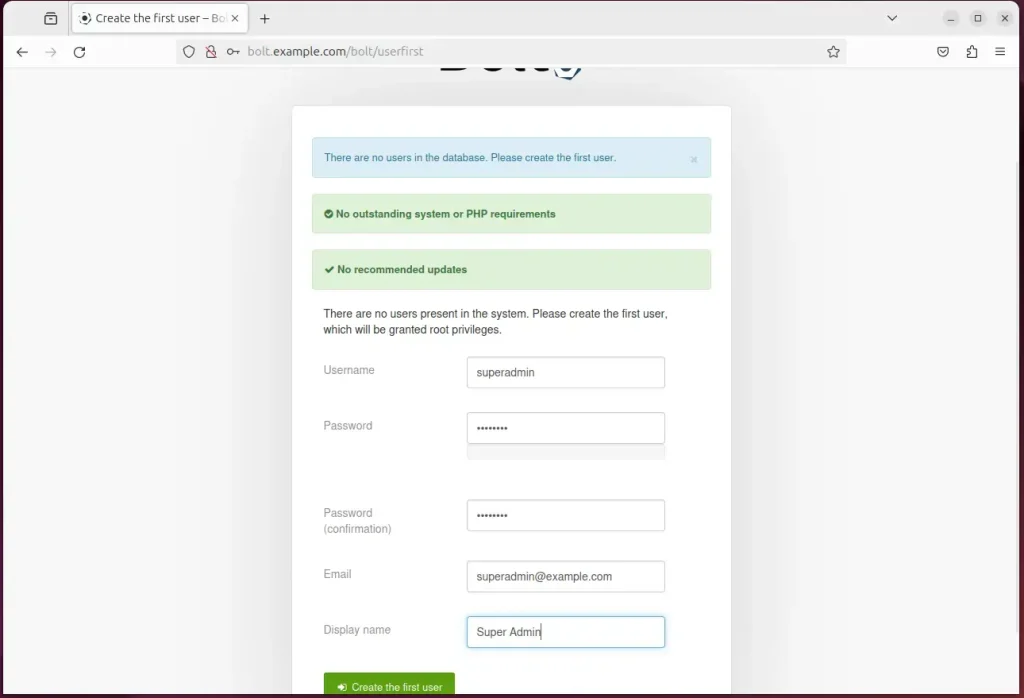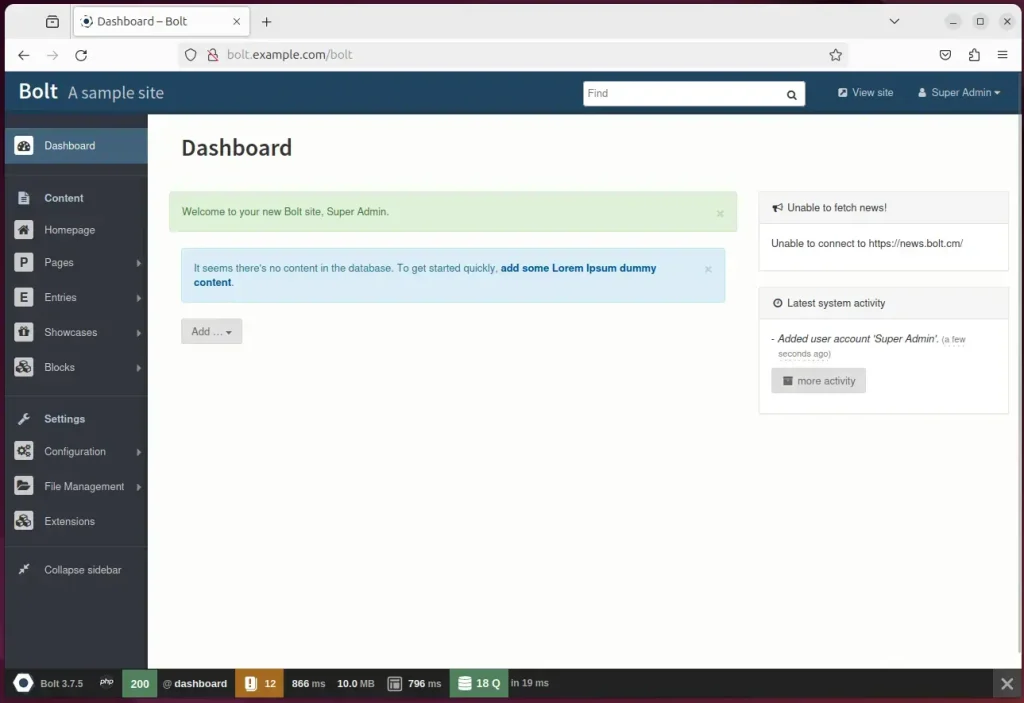This article explains installing Bolt CMS with Nginx support on Ubuntu 24.04.
Installing Bolt CMS with Nginx on Ubuntu brings robustness and performance to your web application. Nginx functions as a high-performance web server, enabling efficient handling of incoming web requests.
On the other hand, Bolt CMS offers a user-friendly interface and convenient content management features. Together, they form a powerful combination for hosting and managing web content.
The steps below walk you through installing Bolt CMS with Nginx on Ubuntu 24.04.
Install Nginx HTTP server on Ubuntu
Bolt requires a web server. This post will install and use the Nginx web server to run Bolt.
To do that, open the Ubuntu terminal and run the commands below to install the Nginx web server.
sudo apt update
sudo apt install nginx
Once Nginx is installed, the commands below can start, stop, and enable the Nginx web server to start automatically when your server boots up.
sudo systemctl stop nginx
sudo systemctl start nginx
sudo systemctl enable nginx
You can test the Nginx web server by opening your web browser and browsing to the server’s localhost or IP address.
http://localhost

When you see the “Welcome to nginx!” page, it means the Nginx HTTP server is successfully installed.
Additional help on installing Nginx on Ubuntu is in the link below.
How to install Nginx on Ubuntu
Install the MariaDB database server on Ubuntu
The next component required to run Bolt is a database server. This post will install and use the MariaDB database server.
To install and use the MariaDB database server, use the instructions below.
Open the Ubuntu terminal and run the commands below to install the MariaDB database server.
sudo apt update sudo apt install mariadb-server
Once the MariaDB database server is installed, use the commands below to stop, start, and enable the MariaDB server to start automatically when the server boots.
sudo systemctl stop mariadb sudo systemctl start mariadb sudo systemctl enable mariadb
Run the following commands to validate and test if the MariaDB database server is installed successfully.
sudo mariadb
Once you run the commands above, it will log you onto the MariaDB console and display a message similar to the one below.
Welcome to the MariaDB monitor. Commands end with ; or \g. Your MariaDB connection id is 32 Server version: 10.11.2-MariaDB-1 Ubuntu 23.04 Copyright (c) 2000, 2018, Oracle, MariaDB Corporation Ab and others. Type 'help;' or '\h' for help. Type '\c' to clear the current input statement. MariaDB [(none)]>
The message tells you that the server is installed successfully.
Additional help on installing MariaDB.
Create a Bolt database
Upon successfully installing the MariaDB database server, create a blank database on the server specifically for the Bolt application.
As part of the setup, we will create a boltdb database and a user account called boltdbuser.
Finally, we’ll grant the boltdbuser full access to the boltdb database.
All the database steps above can be done using the commands below:
But first, log on to the MariaDB database server:
sudo mariadb
Then run the commands below to complete the steps:
CREATE DATABASE boltdb CHARACTER SET utf8mb4 COLLATE utf8mb4_general_ci;
CREATE USER boltdbuser@localhost IDENTIFIED BY 'type_your_password_here';
GRANT ALL ON boltdb.* TO boltdbuser@localhost WITH GRANT OPTION;
FLUSH PRIVILEGES;
exit
Ensure to replace ‘type_your_password_here ‘with your password.
Install PHP-FPM on Ubuntu Linux
The last component you will need to run Bolt is PHP-FPM. The Bolt application is PHP-based and does not support the latest versions of PHP.
To install an older version of PHP-FPM, add this repository.
sudo add-apt-repository ppa:ondrej/php
Then, run the commands below to install the PHP 7.2 version.
sudo apt install php7.2-fpm php7.2-intl php7.2-mysql php7.2-curl php7.2-cli php7.2-zip php7.2-xml php7.2-gd php7.2-common php7.2-mbstring php7.2-xmlrpc php7.2-json php7.2-sqlite3 php7.2-soap php7.2-zip
Additional help on installing PHP
How to install PHP on Ubuntu Linux
Download Bolt files
Let’s begin downloading and configuring the Bolt files on Ubuntu Linux.
First, install Composer, Curl, and other dependencies.
sudo apt install curl git curl -sS https://getcomposer.org/installer | sudo php -- --install-dir=/usr/local/bin --filename=composer
Then, navigate to the /var/www/ directory and clone the Bolt files. Next, make a copy of Bolt’s sample config.yml.dist file to create a new one called config.yml.
cd /var/www
sudo git clone https://github.com/bolt/bolt.git
sudo cp /var/www/bolt/app/config/config.yml.dist /var/www/bolt/app/config/config.yml
Next, open the Bolt config.yml file using the command below.
sudo nano /var/www/bolt/app/config/config.yml
Then, add the database name, username, and password created above. Save the file and exit.
# If you're trying out Bolt, just keep it set to SQLite for now.
database:
driver: mysql
databasename: boltdb
username: boltdbuser
password: your_strong_password
After setting up your environment above, change to the bolt directory and install all required PHP dependencies for Bolt CMS using Composer.
cd /var/www/bolt
sudo composer install
sudo chown -R www-data:www-data /var/www/bolt
Once you have completed all the above steps, continue configuring the Nginx web server below to serve the Bolt content.
Run the commands below to create a Nginx server host file for Bolt.
sudo nano /etc/nginx/sites-available/bolt.conf
Then, copy and paste the content block below into the Nginx server block.
server {
listen 80;
listen [::]:80;
server_name bolt.example.com;
root /var/www/bolt;
index index.php;
location / {
try_files $uri $uri/ /index.php?$query_string;
}
# Generated thumbnail images
location ~* /thumbs/(.*)$ {
try_files $uri $uri/ /index.php?$query_string;
}
# Block PHP files from being run in upload (files), app, theme and extension directories
location ~* /(?:app|extensions|files|theme)/(.*)\.php$ {
deny all;
}
# Block access to Markdown, Twig & YAML files directly
location ~* /(.*)\.(?:dist|markdown|md|twig|yaml|yml)$ {
deny all;
}
location ~ \.php$ {
include snippets/fastcgi-php.conf;
fastcgi_pass unix:/var/run/php/php7.2-fpm.sock;
include fastcgi_params;
fastcgi_intercept_errors on;
}
}
Save the file.
Then, run the commands below to enable the virtual host and restart the Nginx server.
sudo ln -s /etc/nginx/sites-available/bolt.conf /etc/nginx/sites-enabled/
sudo systemctl restart nginx.service
Setup Let’s Encrypt SSL/TLS for Bolt
You may want to install an SSL/TLS certificate to secure your Bolt site. Secure your Bolt installation with HTTPS from Let’s Encrypt.
Please read the post below for additional resources on installing and creating Let’s Encrypt SSL certificates for Nginx.
How to set up Let’s Encrypt SSL certificate for Nginx on Ubuntu Linux
Once you have restarted the Nginx web server, open your browser and browse to the server hostname or IP address defined in the Nginx server block.
http://bolt.example.com/
A Bolt setup wizard page should appear. Create the first user for the site.

Your Bolt site should be set up and ready to use.

That should do it!
Conclusion
- Installing Bolt CMS with Nginx on Ubuntu brings robustness and performance to your web application, with Nginx serving as a high-performance web server and Bolt CMS offering user-friendly interface and content management features.
- The process involves installing Nginx and MariaDB, creating a Bolt database, installing PHP-FPM, downloading Bolt files, configuring Nginx, and securing the site with Let’s Encrypt SSL/TLS.
- Following the step-by-step guide outlined in this article, you can successfully set up and host your web content using the powerful combination of Bolt CMS and Nginx on Ubuntu 24.04.

Leave a Reply